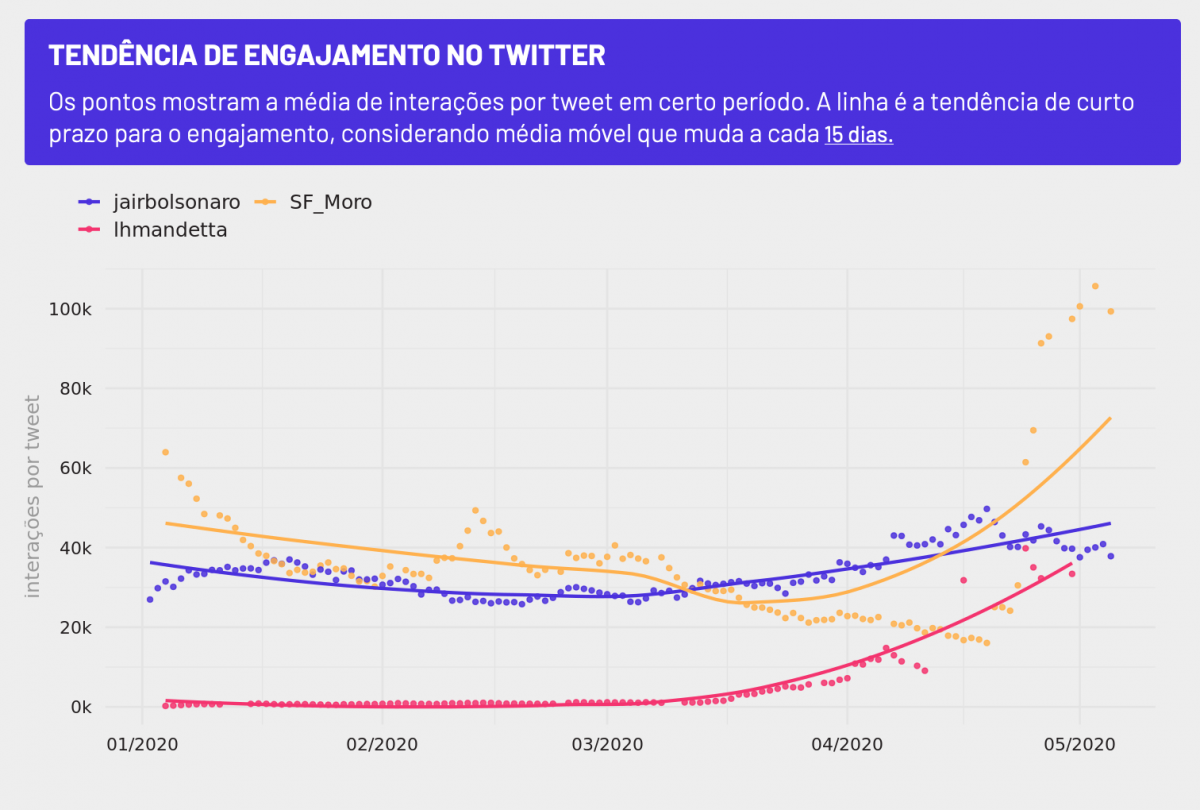How Núcleo Jornalismo is tracking Brazilian politicians on Twitter
Late last month, Brazil’s justice minister Sergio Moro resigned in protest after President Jair Bolsonaro fired his police chief. According to Moro, a prominent politician who may be seeking a presidential run in 2022, Bolsonaro was interfering with the justice department. Last month Bolsonaro also fired his health minister, Luiz Henrique Mandetta, for contradicting the president on the severity of the coronavirus.
Brazilians flocked to Twitter to discuss these political shocks to the country and that surge of social media engagement caught the eye of Sérgio Spagnuolo, editor of data journalism outlet Núcleo Jornalismo. He’d been working on a tool that tracked Brazilian politicians on Twitter and recent events were the perfect case study.
Today, Spagnuolo and his colleagues released Monitor Nuclear, an R Shiny app that allows users to explore Twitter for various engagement metrics related to Brazilian politicians including tweets, retweets and interactions. We caught up with Spagnuolo to talk more about the tool.
Why track Brazil’s politicians on Twitter?
We talk a lot about polling data in Brazil, which is an essential way to evaluate elected officials and potential candidates in upcoming elections. While those polls aim to reflect the entire society and its opinions, they often ignore what is happening in the virtual environment, which generally sets the mood for people.
I have studied Twitter data for a few years now and it is certainly relevant to the political landscape. That is why I decided to build this tool to see how politicians engage with their audiences. Those trends should be only one metric of popularity and are complementary to other research and surveys.
Can you tell us more about how Twitter and politics overlap in Brazil?
With some 14 million users in Brazil, Twitter does not reflect the electorate, of course, but it does reflect the political debate and sets the agenda for politicians and the media, which can be reflected in discussions and actions outside the virtual arena.
Can you cite a few of the findings your “Monitor Nuclear” has generated?
One interesting thing we’ve noticed is that the rift between our president, Jair Bolsonaro, and two of his former top ministers really resulted in a spike of engagement for those politicians. Sergio Moro’s (former justice minister) saw an incredible spike in engagement prior to his departure from government on April 24. The same thing, but on a smaller scale, happened with Henrique Mandetta (the former health minister) after he was fired on April 17.
Those engagements could indicate a spike in popularity and endorsement, which is interesting as we are already talking about potential candidates for the general election in 2022.

How has Brazilian political discourse on Twitter changed over time? Pre-Bolsonaro or pre-Covid?
Our tool does not analyze discourse and qualitative metrics. We mostly gather metadata in order to evaluate popularity and engagement trends. We are still gathering data from before Bolsonaro took office. Some officials in our tool did not even have a Twitter account before 2019. We still have to figure that out.
What is considered engagement under your methodology and why does this metric matter?
Engagement in our tool is considered through a combination of number of tweets per day as well as favorites and retweets put together within a rolling average to attenuate variations in time. We considered this our main metric because likes and retweets can only be made once per user in a tweet.
It’s like voting, in a very reduced sense. If you favorite something, chances are you are vouching for some message, and if you retweet it, it generally means (with exceptions of course) that you endorse a message. With likes and retweets, you cannot blow the counts out of proportion very easily, because even bots can only like and retweet a tweet once.
Does the tool account for potential bots trying to force conversations into people’s feeds?
Not really. The reason we did not consider comments as an engagement metrics in our tool (although they are) is that a bot or person could make 100 comments or more on a post and artificially increase its popularity. Also, comments are not indications of endorsement, they can be spam, critical and even cruel.





